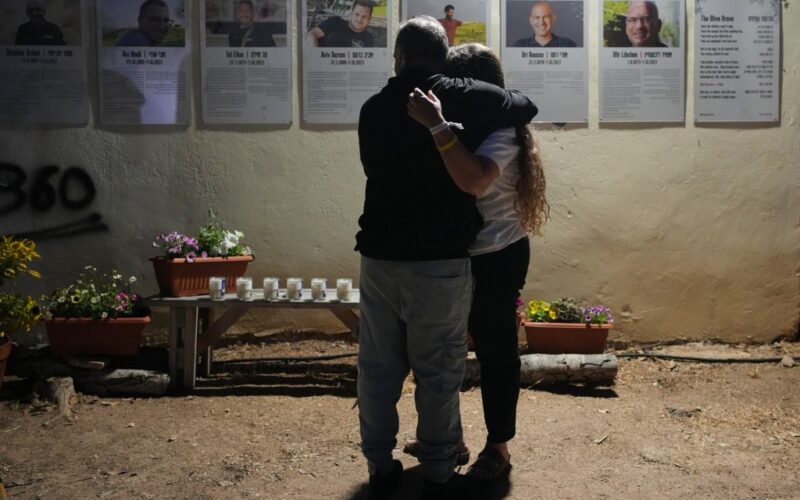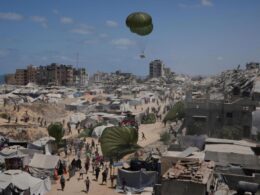By JOSEPH KRAUSS, Associated Press
Two years after Hamas’ attack ignited the war in the Gaza Strip, the group is weakened but not defeated, Israel has clobbered its enemies across the region but failed to achieve its main goals, and no one knows how it all will end.
The Oct. 7, 2023, attack, the deadliest on Israeli soil, sparked one of the most devastating military campaigns since World War II, leaving tens of thousands of Palestinians dead, flattening vast areas of the blockaded territory and triggering a famine in parts.
It sent ripples across the region, bringing Israel into combat with Lebanon’s Hezbollah, Yemen’s Houthi rebels, as well as militant groups in Iraq and Syria, and their patron, Iran, which suffered major losses in a 12-day war launched by Israel earlier this year.
Through it all, Hamas has held onto hostages — it still has 48, around 20 of whom Israel believes are alive — and maintained influence in the dwindling areas of Gaza that haven’t been destroyed and largely depopulated.
A new round of ceasefire talks began this week based on a peace plan advanced by U.S. President Donald Trump. But so far, two U.S. administrations have failed to end the fighting while providing crucial support for an increasingly isolated and internally divided Israel.
A regional hegemon, globally isolated
Israel has inflicted major damage on Iran and its allies, emerging as the unquestionably dominant military power in the Middle East, with full control over most of Gaza and parts of Lebanon and Syria.
It showed off powerful military and intelligence capabilities with an attack on Hezbollah using exploding pagers and long-range strikes that took out senior militants, Iranian generals and nuclear scientists.
But its tactical victories have come at an enormous cost.
Israel is more isolated internationally than it has been in decades, with experts, scholars and major rights groups accusing it of genocide, charges it vehemently denies. The International Criminal Court has issued arrest warrants for Prime Minister Benjamin Netanyahu and his former defense minister, accusing them of using starvation as a method of warfare, allegations they deny. Normalization with Saudi Arabia and other Arab countries appears increasingly remote.
The failure to return the hostages, on top of long-standing corruption allegations against Netanyahu and his efforts to overhaul Israel’s judiciary, have left the country furiously divided, with weekly mass protests and discontent mounting as Israel wages another major offensive in Gaza.
Palestinian statehood looks more remote despite growing recognition
Hamas has said the Oct. 7 attack, in which fighters killed some 1,200 people and abducted 251, was partly aimed at returning the Palestinian cause to the world’s agenda. It did manage to do that.
As the ensuing war has dragged on, major Western countries have joined a majority of U.N. members in recognizing a Palestinian state. The International Court of Justice has said Israel’s control over east Jerusalem, the West Bank and Gaza, territories it seized in the 1967 Mideast war, is an illegal occupation that must end.
But on the ground, Israel has further cemented its rule over all the lands between the Jordan River and the Mediterranean Sea, further dashing any hopes for Palestinian independence.
The offensive in Gaza has killed tens of thousands of Palestinians, according to local health authorities, and displaced 90% of the population of some 2 million, often multiple times. Israel controls around 75% of the territory, and entire cities and towns are in ruins. Most Palestinians have seen their homes destroyed, children have missed two years of school, and parts of Gaza have plunged into famine. Whenever the war does end, it will take years, if not generations, for Gaza to recover.
In the occupied West Bank, Israel has carried out major military operations that it says are aimed at rooting out combatants, displacing tens of thousands. And it is rapidly expanding Jewish settlements, including a major project that would split the territory in half and is aimed at making it all but impossible to create a viable Palestinian state.
Hamas and Netanyahu have held on through it all
Plenty of Palestinians are furious with Hamas — which has been designated a terrorist organization by the United States, Canada and European Union — for triggering the death and destruction. Plenty of Israelis are angry at Netanyahu for failing to reach an agreement to bring the hostages home after presiding over Israel’s greatest security failure.
But it’s too soon to count either of them out.
In addition to the hostages, Hamas has a vastly diminished but still potent guerrilla force capable of sporadic attacks — and of rebuilding, if given the chance. It could still claim an incredibly costly victory if it trades the hostages for a full Israeli withdrawal and the release of hundreds of Palestinian prisoners. Its very survival might be enough for its remaining leadership.
Netanyahu, Israel’s longest-serving prime minister, has held onto power by meeting the demands of his far-right coalition allies to continue the war.

He’ll face elections next year and could lose, especially if the hostages haven’t been returned and Hamas survives. But he has a powerful ally in Trump, who may yet succeed in ending the war and bringing the captives home. Without any clear leader among Israel’s divided opposition, that might be enough to allow Netanyahu to eke out yet another narrow victory.
US, in lockstep with Israel, has failed to end the fighting
In January of this year, there was some hope the war might end.
Trump’s incoming team had pushed a ceasefire agreement over the finish line after months of negotiations mediated by President Joe Biden’s administration, Egypt and Qatar. The phased plan was designed to wind down the war and return the remaining hostages.
In March, Israel imposed a total blockade on Gaza that would last for 2 1/2 months and ended the truce with a surprise bombardment. It faced no public pushback from Trump, who a month earlier had floated the idea of depopulating Gaza and turning it into a tourist destination.
Under both Biden and Trump, the U.S. has provided billions of dollars in military aid while shielding Israel from international calls for a ceasefire and defending it against allegations of atrocities.
Unwavering U.S. support has allowed Netanyahu to pursue “total victory” over Hamas despite the humanitarian catastrophe. U.S. proposals to end the fighting have strongly favored Israel, and Hamas has refused to give in despite its staggering losses.
The latest peace plan from the White House calls on Hamas to immediately release all the remaining hostages, give up power and disarm. In return, Israel would release hundreds of Palestinian prisoners and withdraw from much of Gaza. The U.S. would guarantee an influx of humanitarian aid and eventual reconstruction, and plans to relocate much of Gaza’s population to other countries would be shelved.
Gaza would be placed under international governance without a clear path to reunification with the West Bank in a future Palestinian state.
Hamas has said it is willing to release the hostages and hand over power to other Palestinians, but that other aspects of the plan require further negotiation. Trump and Netanyahu want a quick deal, and Israel could once again escalate the war if talks drag on.
Even if the fighting can be brought to an end, it’s unclear when — or even if — Gaza can be rebuilt, and the broader Israeli-Palestinian conflict, which predates the war by decades, would remain volatile as ever.
Joseph Krauss has been reporting on the Middle East for more than two decades, including several years based in Israel and the Palestinian territories.
Follow AP’s war coverage at https://apnews.com/hub/israel-hamas-war








